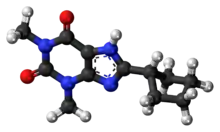 | |
 | |
| Clinical data | |
|---|---|
| ATC code |
|
| Legal status | |
| Legal status |
|
| Identifiers | |
| |
| CAS Number | |
| PubChem CID | |
| IUPHAR/BPS | |
| ChemSpider |
|
| UNII | |
| ChEBI | |
| ChEMBL | |
| CompTox Dashboard (EPA) | |
| Chemical and physical data | |
| Formula | C12H16N4O2 |
| Molar mass | 248.286 g·mol−1 |
| 3D model (JSmol) | |
| |
| |
| (verify) | |
8-Cyclopentyl-1,3-dimethylxanthine (8-Cyclopentyltheophylline, 8-CPT, CPX) is a drug which acts as a potent and selective antagonist for the adenosine receptors, with some selectivity for the A1 receptor subtype, as well as a non-selective phosphodiesterase inhibitor. It has stimulant effects in animals with slightly higher potency than caffeine.[1][2]
See also
References
- ↑ Spealman RD (1988). "Psychomotor stimulant effects of methylxanthines in squirrel monkeys: relation to adenosine antagonism". Psychopharmacology. 95 (1): 19–24. doi:10.1007/bf00212759. PMID 3133696. S2CID 11539292.
- ↑ Karcz-Kubicha M, Antoniou K, Terasmaa A, Quarta D, Solinas M, Justinova Z, et al. (July 2003). "Involvement of adenosine A1 and A2A receptors in the motor effects of caffeine after its acute and chronic administration". Neuropsychopharmacology. 28 (7): 1281–91. doi:10.1038/sj.npp.1300167. PMID 12700682.
| Receptor (ligands) |
| ||||||||||
|---|---|---|---|---|---|---|---|---|---|---|---|
| Transporter (blockers) |
| ||||||||||
| Enzyme (inhibitors) |
| ||||||||||
| Others | |||||||||||
See also: Receptor/signaling modulators | |||||||||||
This article is issued from Wikipedia. The text is licensed under Creative Commons - Attribution - Sharealike. Additional terms may apply for the media files.